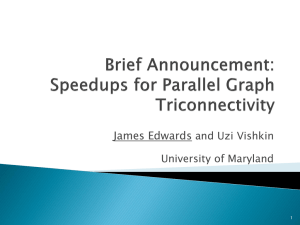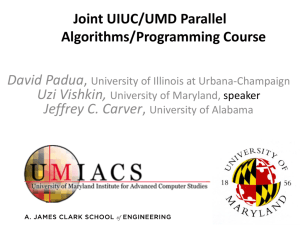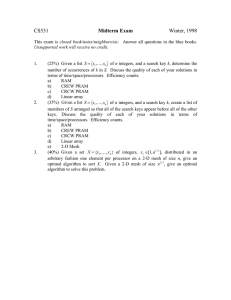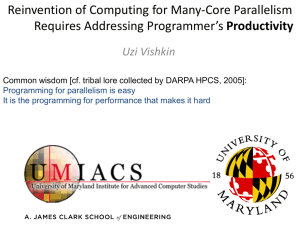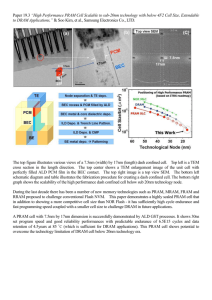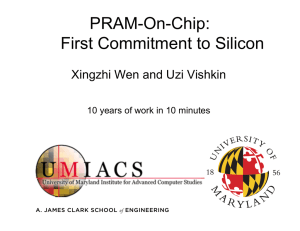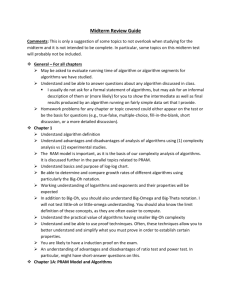Can PRAM Graph Algorithms Provide Practical Speedups on Many-Core Machines?
advertisement
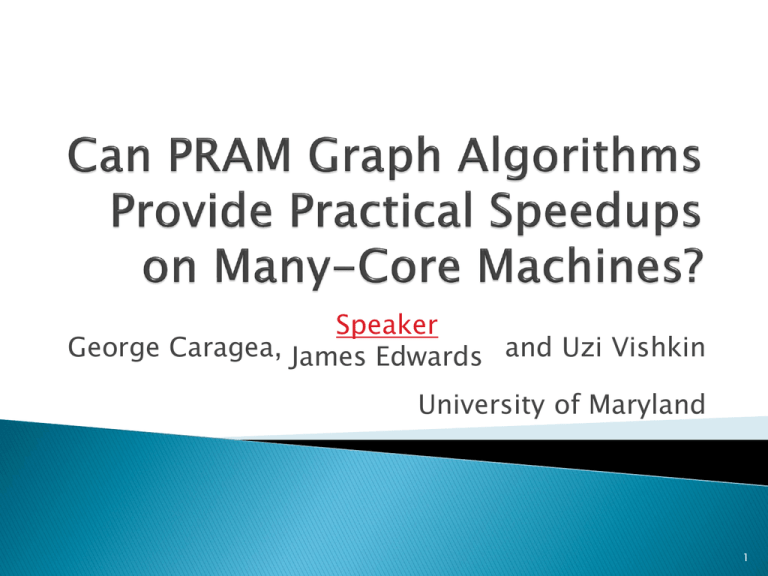
Speaker George Caragea, James Edwards and Uzi Vishkin University of Maryland 1 It has proven to be quite difficult to obtain significant performance improvements using current parallel computing platforms. National Research Council report: While heroic programmers can exploit today vast amounts of parallelism, whole new computing “stacks” are required to allow expert and typical programmers to do that easily. 2 The Parallel Random Access Machine (PRAM) is the simplest model of a parallel computer. ◦ Work-Depth is a conceptually simpler model that is equivalent to the PRAM. ◦ At each point in time, specify all operations that can be performed in parallel. ◦ Any processor can access any memory address in constant time. Advantages ◦ Ease of algorithm design ◦ Provability of correctness ◦ Ease of truly PRAM-like programming So, what’s the problem? 3 Many doubt the direct practical relevance of PRAM algorithms. ◦ Example: lack of any poly-logarithmic PRAM graph algorithms in the new NSF/IEEE-TCPP curriculum Past work provided very limited evidence to alleviate these doubts. Graph algorithms in particular tend to be difficult to implement efficiently, as shown in two papers from Georgia Tech: ◦ Biconnectivity (IPDPS ‘05, 12-processor Sun machine): Speedups of up to 4x with a modified version of the Tarjan-Vishkin biconnectivity algorithm No speedup without major changes to the algorithm ◦ Maximum flow (IPDPS ‘10, hybrid GPU-CPU implementation): Speedups of up to 2.5x 4 Cause: PRAM algorithms are not a good match for current hardware: ◦ Fine-grained parallelism = overheads Requires managing many threads Synchronization and communication are expensive Clustering reduces granularity, but at the cost of load balancing ◦ Irregular memory accesses = poor locality Cache is not used efficiently Performance becomes sensitive to memory latency Unlike models such as BSP and LogP, PRAM does not explicitly take these factors into account. 5 The Explicit Multi-Threading (XMT) architecture was developed at the University of Maryland with the following goals in mind: ◦ Good performance on parallel algorithms of any granularity ◦ Support for regular or irregular memory access ◦ Efficient execution of code derived from PRAM algorithms A 64-processor FPGA hardware prototype and a software toolchain (compiler and simulator) are freely available for download. Note: Unless otherwise specified, speedup results for XMT were obtained using the simulator and are given in terms of cycle counts. 6 Main feature of XMT: Using similar hardware resources (e.g. silicon area, power consumption) as existing CPUs and GPUs, provide a platform that to a programmer looks as close to a PRAM as possible. ◦ Instead of ~8 “heavy” processor cores, provide ~1,024 “light” cores for parallel code and one “heavy” core for serial code. ◦ Devote on-chip bandwidth to a high-speed interconnection network rather than maintaining coherence between private caches. 7 ◦ For the PRAM algorithms presented, the number of HW threads is more important than the processing power per thread because they happen to perform more work than an equivalent serial algorithm. This cost is overridden by sufficient parallelism in hardware. ◦ Balance between the tight synchrony of the PRAM and hardware constraints (such as locality) is obtained through support for fine-grained multithreaded code, where a thread can advance at it own speed between (a form of) synchronization barriers. 8 Consider the following two systems: 1. 2. XMT running a PRAM algorithm with few or no modifications A multi-core CPU or GPU running a heavily modified version of the same PRAM algorithm or another algorithm solving the same problem It is perhaps surprising that (1) can outperform (2) while being easier to implement. This idea was demonstrated with the following four PRAM graph algorithms: ◦ ◦ ◦ ◦ BFS Connectivity Biconnectivity Maximum flow 9 None of 40+ students in a fall 2010 joint UIUC/UMD course got any speedups using OpenMP programming on simple irregular problems such as breadth-first search (BFS) using an 8-processor SMP, but they got 8x25x speedups on the XMT FPGA prototype. On BFS, we show potential speedups of 5.4x over an optimized GPU implementation, 73x when the input graph provides low degree of parallelism during execution. 10 Using the Shiloach-Vishkin (SV) PRAM algorithm for connectivity, we show potential speedups of 39x-100x over a best serial implementation and 2.2x-4x over an optimized GPU implementation that greatly modified the original algorithm. In fact, for XMT the SV PRAM connectivity algorithm did not need to wait for a research paper. It was given as one of 6 programming assignments in standard PRAM algorithm classes, and was even done by a couple of 10th graders at Blair High School, Maryland. 11 Dataset 1kv-500ke-complete 20kv-5me-random 1mv-3me-planar USA-road-d.LKS web-Google-con Description Complete graph Random graph Maximal planar graph Great Lakes road graph Google web graph Nodes 1,000 20,000 1,000,002 2,758,119 855,802 Edges 499,500 5,000,000 3,000,000 3,397,404 4,291,352 Complete graph: Every vertex is connected to every other vertex Random graph: Edges are added at random between unique pairs of vertices Great lakes road graph: From the 9th DIMACS Implementation Challenge Google web graph: Undirected version of the largest connected component of the Google web graph of web pages and hyperlinks between them, from the Stanford network analysis platform 12 Maximal planar graph ◦ Built layer by layer ◦ The first layer has three vertices and three edges. ◦ Each additional layer has three vertices and nine edges. 13 49.09 65.06 13.45 19.04 38.99 57.35 20 20.45 27.11 40 6.60 13.13 60 10.98 15.41 80 XMT 2048 64.54 67.56 100 99.85 XMT 1024 120 (higher is better) Speedup relative to serial 140 16.58 23.82 GTX 480 (Fermi) 89.75 109.53 135.79 GTX 280 (Tesla) 0 1kv-500ke- 20kv-5me- 1mv-3me- USA-road- Web- complete random planar d.LKS Google-con Dataset 14 On biconnectivity, we show potential speedups of 9x-33x using a direct implementation of the Tarjan-Vishkin (TV) biconnectivity algorithm, a logarithmic-time PRAM algorithm. When compared with two other algorithms, one based on BFS and the other on DFS, TV was the only algorithm that provided strong speedups on all evaluated input graphs. ◦ The other algorithms use less work but lose out to TV on balance Furthermore, TV provided the best speedup on sparse graphs. 15 pDFS 30 TV 25 TV-BFS 20 15 10 5 2048 1024 64 2048 1024 64 2048 1024 64 2048 1024 64 2048 1024 0 64 (higher is better) Speedup relative to serial DFS 35 1kv-500ke- 20kv-5me- 1mv-3me- USA-road- web-Google- complete random planar d.LKS con top: # TCUs bottom: Dataset 16 Biconnectivity provides a good example of how programming differs between XMT and other platforms. For both XMT and SMPs, a significant challenge was to improve the work efficiency of subroutines used within the biconnectivity algorithm. 17 On XMT, we left the core algorithm as is without reducing its available parallelism ◦ When computing graph connectivity (first on the input graph, then on an auxiliary graph), compact the adjacency list every few iterations ◦ When computing the preorder numbering of the spanning tree of the input graph, accelerate the iterations by choosing faster but more work demanding list ranking algorithms for different iterations (“accelerating cascades”, [CV86]) ◦ Transition as many computations as possible from the original input graph to the spanning tree. In contrast, speedups on SMPs could not be achieved without reducing the parallelism of TV (e.g. by performing a DFS traversal of the input graph), effectively replacing many of its components 18 On maximum flow, we show potential speedups of up to 108x compared to a modern CPU architecture running a best serial implementation. The XMT solution is a PRAM lock-free implementation, based on balancing the GoldbergTarjan Push-Relabel algorithm with the first PRAM max-flow algorithm (SV). Performance is highly dependent on the structure of the graph, determined by: ◦ The amount of parallelism available during execution ◦ The number of parallel steps (kernel invocations) ◦ The amount of memory queuing due to conflicts 19 Dataset ADG Description Acyclic Dense Graph Washington Random RLG Level Graph RMF-WIDE GenRMF Wide Graph RMF-LONG GenRMF Long Graph RANDOM Radom Graph Nodes 1,200 Edges 719,400 131,074 8,192 8,192 65,536 391,168 23,040 22,464 96,759 Acyclic Dense Graphs (ADG) ◦ From 1st DIMACS Challenge [JM93] ◦ Complete direct acyclic graphs ◦ Node degrees range between N-1 to 1 Washington Random Level Graphs (RLG) ◦ From 1st DIMACS Challenge [JM93] ◦ Rectangular grids. Each vertex in a row has three edges to randomly chosen vertices in next row ◦ Source and sink external to grid, connected to first and last row RMF Graphs ◦ From 1st DIMACS Challenge [JM93] and [GG88] ◦ a square grids of vertices (frames), with b x b vertices per frame. N=axbxb ◦ Each vertex connected to neighbors in frame, and one random vertex in next frame ◦ Source in first frame, sink in last frame ◦ RMF long: many “small” frames; RMF wide: fewer “large” frames. RANDOM ◦ ◦ ◦ ◦ Random unstructured graphs Edges are placed uniformly at random between pairs of nodes Average degree is 6 Short diameter, high degree of parallelism (higher is better) Speedup 5 1.56 0.88 0.18 8.10 4.91 15 1.76 1.09 0.18 1.70 0.31 2.83 0.02 10 7.95 108.33 16.19 20 PR.1024 PR.64 cuda_mf 0 22 These experimental algorithm results show not only that theory-based algorithms can provide good speedups in practice, but also that they are sometimes the only ones that can do so. Perhaps most surprising to theorists would be that the nominal number of processors is not as important for a fair comparison among same-generation many-core platforms as silicon area. 23 [CB05] G. Cong and D.A. Bader. An Experimental Study of Parallel Biconnected Components Algorithms on Symmetric Multiprocessors (SMPs). In Proc. 19th IEEE International Parallel and Distributed Processing Symposium., page 45b, April 2005. [CKTV10] G. C. Caragea, F. Keceli, A. Tzannes, and U. Vishkin. General-purpose vs. GPU: Comparison of many-cores on irregular workloads. In HotPar ’10: Proceedings of the 2nd Workshop on Hot Topics in Parallelism. USENIX, June 2010. [CV86] R. Cole, U. Vishkin. Deterministic coin tossing and accelerating cascades: micro and macro techniques for designing parallel algorithms. In Proc. STOC 1986. [CV11] G. Caragea, U. Vishkin. Better Speedups for Parallel MaxFlow. Brief Announcement, SPAA 2011. 24 [EV11] J. Edwards and U. Vishkin. An Evaluation of Biconnectivity Algorithms on Many-Core Processors. 2011. Under review. [FM10] S.H. Fuller and L.I. Millett (Eds.). The Future of Computing Performance: Game Over or Next level. Computer Science and Telecommunications Board, National Academies Press, December 2010. [GG88] D. Goldfarb and M. Grigoriadis. A Computational Comparison of the Dinic and Network Simplex Methods for Maximum Flow. Annals of Operations Research, 13:81-123, 1988. [GT88] A.Goldberg, R.Tarjan, A new approach to the maximum-flow problem Journal of ACM, 1988. 25 [HH10] Z. He and Bo Hong, Dynamically Tuned PushRelabel Algorithm for the Maximum Flow Problem on CPUGPU-Hybrid Platforms. In Proc. 24th IEEE International Parallel and Distributed Processing Symposium (IPDPS'10), 2010. [JM93] D.S. Jonson and C.C. McGeoch, editors. Network Flows and Matching: First DIMACS Implementation Challenge. AMS, Providence, RI, 1993. [KTCBV11] F. Keceli, A. Tzannes, G. Caragea, R. Barua and U. Vishkin. Toolchain for programming, simulating and studying the XMT many-core architecture. Proc. 16th Int. Workshop on High-Level Parallel Programming Models and Supportive Environments (HIPS), in conjunction with IPDPS, Anchorage, Alaska, May 20, 2011, to appear. 26 [SV82a] Y. Shiloach and U. Vishkin. An O(log n) parallel connectivity algorithm. J. Algorithms, 3(1):57–67, 1982. [SV82b] Y. Shiloach and U. Vishkin. An O(n2 log n) parallel maxflow algorithm. J. Algorithms, 3:128–146, 1982. [TCPP10] NSF/IEEE-TCPP curriculum initiative on parallel and distributed computing - core topics for undergraduates. http://www.cs.gsu.edu/˜tcpp/curriculum/index.php, December 2010. [TV85] R. E. Tarjan and U. Vishkin. An Efficient Parallel Biconnectivity Algorithm. SIAM J. Computing, 14(4):862–874, 1985. [WV08] X. Wen and U. Vishkin. FPGA-Based Prototype of a PRAMon-Chip Processor. In Proceedings of the 5th Conference on Computing Frontiers, CF ’08, pages 55–66, New York, NY, USA, 2008. ACM. 27
